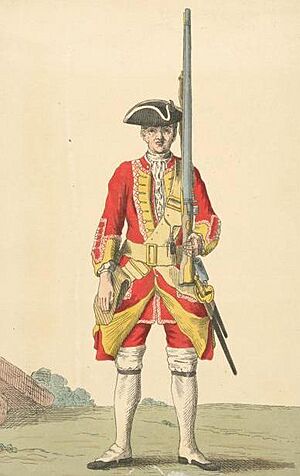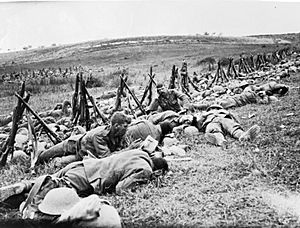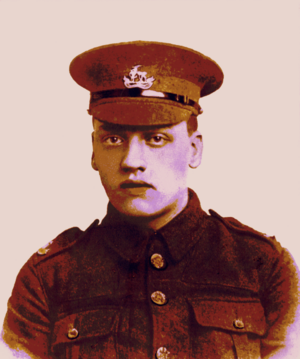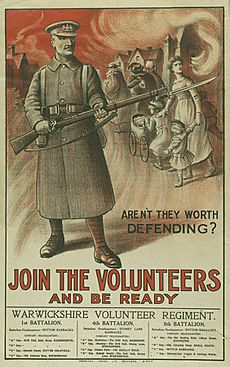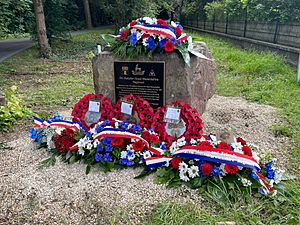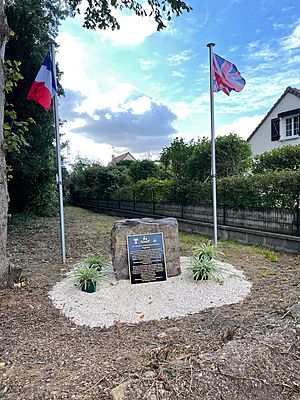Royal Warwickshire Regiment facts for kids
Quick facts for kids 6th Regiment of Foot6th (1st Warwickshire) Regiment of Foot 6th (Royal First Warwickshire) Regiment of Foot Royal Warwickshire Regiment Royal Warwickshire Fusiliers |
|
|---|---|
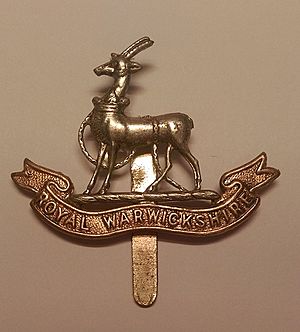
Royal Warwickshire Regiment Cap Badge
|
|
| Active | 1685–1968 |
| Country | |
| Branch | |
| Type | Infantry |
| Role | Line infantry |
| Size | 1–4 Regular battalions Up to 2 Militia battalions |
| Garrison/HQ | Budbrooke Barracks, Warwickshire |
| Nickname(s) | Saucy Sixth |
| March | Quick: The British Grenadiers, Warwickshire Lads Slow: MacBean's Slow March |
| Mascot(s) | Indian black buck antelope, 'Bobby' |
| Insignia | |
| Hackle (When a Fusilier Regiment) | Royal Blue over old gold with a touch of Dutch pink |
The Royal Warwickshire Regiment was a famous line infantry regiment of the British Army. It existed for 283 years, from 1685 to 1968. This regiment fought in many important wars and conflicts. These included the Second Boer War and both the First and Second World Wars.
On 1 May 1963, the regiment changed its name one last time. It became the Royal Warwickshire Fusiliers and joined the Fusilier Brigade. In 1968, the regiment was combined with other fusilier regiments. These were the Royal Northumberland Fusiliers, the Royal Fusiliers (City of London Regiment), and the Lancashire Fusiliers. Together, they formed a new, larger regiment called the Royal Regiment of Fusiliers. The Royal Warwickshire Fusiliers became the 2nd Battalion of this new regiment.
Contents
History of the Regiment
Early Years: 17th Century
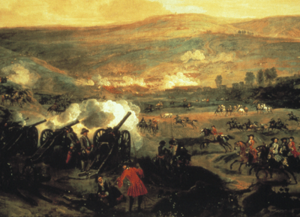
The regiment started in December 1673. It was first part of the Dutch Anglo-Scots Brigade, a group of soldiers who worked for different countries. They fought in the 1672–1678 Franco-Dutch War. They took part in the Siege of Maastricht and battles like Cassel.
In 1685, the regiment came to England to help King James II. It was then officially named the 6th Regiment of Foot. In 1688, it joined William III during the Glorious Revolution.
The regiment fought in the Williamite War in Ireland from 1689–1691. They were at the Battle of the Boyne in July 1690. They also fought at Aughrim and the Second Siege of Limerick.

In 1692, the regiment went to Flanders. They were almost completely destroyed at the Battle of Steenkerque in July. They won their first special award, called a battle honour, for the Siege of Namur in 1695. After the Nine Years War ended in 1697, the regiment moved to Ireland.
Fighting Around the World: 18th Century
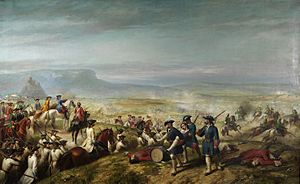
When the War of the Spanish Succession began, the regiment went to the West Indies in 1703. This was a very unhealthy place, and many soldiers got sick. They also fought in Spain and Portugal. This included the Almansa in 1707 and the capture of Minorca in 1708. In 1710, they were captured at Brihuega. After the war, they stayed in Ireland until 1740.
In 1741, the regiment returned to the West Indies during the War of Jenkins' Ear. They took part in the expedition to Cartagena de Indias in modern Colombia. Most of the soldiers (80-90%) died from diseases like dysentery and yellow fever. The few survivors came back to England in 1742.
The regiment then went to Scotland. During the Jacobite Rising in 1745, some of their companies were captured. Others defended Fort William in 1746. After the Culloden, they helped calm the Highlands.
The regiment spent 19 years in Gibraltar before moving to the West Indies in 1772. During the American War of Independence, parts of the 6th Regiment fought in New York in 1776. To help get more soldiers, each infantry unit was linked to a county in 1782. The 6th became the 6th (1st Warwickshire) Regiment. In 1794, during the French Revolutionary Wars, they helped invade Martinique, Guadeloupe, and Saint Lucia.
Growth and Action: 19th Century
The 1st Battalion went to the Iberian Peninsula in 1808. They fought at Roliça and Vimeiro. They also took part in the Corunna, losing 400 men during the difficult march. After a short time in the UK, they returned to the Peninsula in 1812.
The regiment was at Vitoria in 1813. They fought hard at Roncesvalles. At the Heights of Echalar in August 1813, the famous General Wellington saw their attack. He called it "The most gallant and the finest thing he had ever witnessed." They also fought at Orthez in 1814.
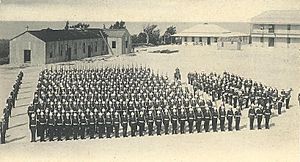
In 1832, the 6th became a Royal Regiment. Its name changed to the Royal (1st) Warwickshire Regiment. They fought in the 7th and 8th Xhosa Wars in South Africa. They also helped stop the Indian Rebellion in 1857.
In 1881, the regiment officially became the Royal Warwickshire Regiment. It was the county regiment for Warwickshire, including Birmingham. It now included regular, militia, and volunteer battalions. In 1898, the regiment fought in the Sudan at Atbara and Omdurman. They also served in the Second Boer War at Diamond Hill and Bergendal.
The 20th Century: World Wars and Beyond
First World War (1914-1918)
The 1st Battalion arrived in France in August 1914. They fought on the Western Front. Bernard Montgomery, who later became a very famous general, served with them. He fought at the Battle of Le Cateau and during the retreat from Mons. The 2nd Battalion arrived in Belgium in October 1914. They also fought on the Western Front and later moved to Italy.
Second Lieutenant Euan Lucie-Smith was an officer in the 1st Battalion. He was one of the first mixed-heritage infantry officers in the British Army. He was also the first such officer killed in World War I, on 25 April 1915.
Many other battalions were formed for the war. The 1/5th, 1/6th, 1/7th, and 1/8th Battalions arrived in France in March 1915. They fought on the Western Front and then moved to Italy. The 2/5th, 2/6th, 2/7th, and 2/8th Battalions also fought on the Western Front from May 1916.
New battalions were also created, called "New Armies." The 9th (Service) Battalion landed in Gallipoli in July 1915. They later moved to Egypt and then to Mesopotamia. William Slim, another future famous general, served with this battalion.
The 14th, 15th, and 16th (Service) battalions were formed in Birmingham. They were known as the Birmingham Pals. They arrived in France in November 1915 and fought on the Western Front. They later moved to Italy and then back to France.
Second World War (1939-1945)
Regular Army Battalions
The 1st Battalion was in British India from 1937 to 1939. During the war, they mostly did guard duties. They trained for jungle warfare in late 1944. They briefly fought in the final parts of the Burma Campaign in April 1945. They helped capture Rangoon.
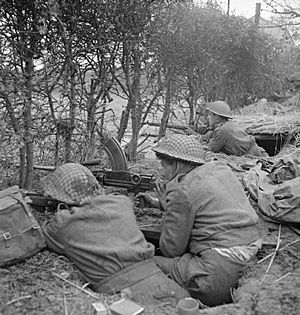
The 2nd Battalion was in England when the war started. In September 1939, they went to France to join the British Expeditionary Force (BEF). They fought in the Battle of France in May 1940. They defended against attacks at Escaut and Wormhoudt. They were involved in the Wormhoudt massacre. They also fought during the retreat to Dunkirk and were evacuated to England.
After Dunkirk, the 2nd Battalion trained in England. In September 1942, they joined the 3rd Infantry Division. They landed on D-Day (June 6, 1944) as part of the first attack on the Normandy beaches. They fought in the Battle for Caen and the breakout from Normandy. They also took part in the Rhine crossing and the capture of Bremen. From D-Day until the end of the war, the 2nd Battalion lost 286 soldiers killed. Nearly 1,000 more were wounded or missing.
Territorial Army Battalions
Some battalions, like the 5th and 6th, became anti-aircraft units before the war. The 5th Battalion fought in the Burma Campaign.
The 1/7th Battalion went to France in early 1940. They fought hard along the Ypres–Comines Canal. This fighting allowed other British forces to retreat towards Dunkirk. Like the 2nd Battalion, the 1/7th was also driven back to Dunkirk. They lost most of their men. In October 1942, they moved to Northern Ireland. They served with the 59th Division in France during Operation Overlord (the Battle of Normandy). This division was considered one of the best by General Bernard Montgomery. However, it was disbanded in August 1944 due to a shortage of infantry soldiers.
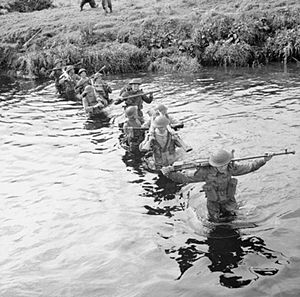
The 8th Battalion also fought in France in 1940 and was evacuated from Dunkirk. They spent many years in the UK defending against a possible German invasion. The 2/7th and 9th Battalions were formed in 1939. They stayed in the United Kingdom throughout the war.
Hostilities-Only Battalions
The 12th (Garrison) Battalion was formed in November 1939. Its job was to guard important areas overseas. They went to France in March 1940 and were evacuated from Brest and St. Malo. They were later disbanded.
The 13th Battalion was formed in July 1940. Later, it became a battalion of the new Parachute Regiment. It was renamed the 8th (Midlands) Parachute Battalion. This battalion took part in Operation Tonga (the British airborne drop before D-Day). They also fought in the Normandy Campaign, the Battle of the Bulge, and Operation Varsity, a huge airborne drop.
The 50th (Holding) Battalion was formed in May 1940. It trained new recruits and defended the coast. It was later renamed the 14th Battalion. The 70th (Young Soldiers) Battalion was formed for volunteers aged 18-19. It was known as one of the best young soldiers' battalions. It was disbanded in August 1943.
After the Wars
The 1st Battalion served in India (1945–1947) and Korea (1953–1954) during the Korean War. They also served in Cyprus (1955–1959) and Aden (1959–1960). The 2nd Battalion was in Palestine from 1945 to 1948.
In 1958, the regiment was reduced to one regular battalion. In 1963, the Queen approved the regiment becoming "fusiliers." They were renamed the Royal Warwickshire Fusiliers. As fusiliers, they could wear a special colored feather, called a hackle, in their hats. The colors chosen were royal blue over orange, which came from the regiment's Dutch origins.
On 23 April 1968, the Royal Warwickshire Fusiliers combined with other regiments. They became part of the Royal Regiment of Fusiliers.
Memorial at Lébisey
There is a memorial at Lébisey in Normandy, France. It marks the site of a battle in 1944. This memorial was officially opened on 7 June 2022.
Regimental Museum
The Royal Regiment of Fusiliers Museum (Royal Warwickshire) is located at St John's House in Warwick. You can visit it to learn more about the regiment's history.
Battle Honours
Battle honours are special awards given to regiments for their bravery in battles. The Royal Warwickshire Regiment earned many:
- Namur 1695, Martinique 1794, Rolica, Vimiera, Corunna, Vittoria, Pyrenees, Nivelle, Orthes, Peninsula, Niagara, South Africa 1846–47, 1851–53, Atbara, Khartoum, South Africa 1899–1902
- The Great War: Le Cateau, Retreat from Mons, Marne 1914, Aisne 1914 '18, Armentières 1914, Ypres 1914 '15 '17, Langemarck 1914 '17, Gheluvelt, Neuve Chapelle, St. Julien, Frezenberg, Bellewaarde, Aubers, Festubert 1915, Loos, Somme 1916 '18, Albert 1916 '18, Bazentin, Delville Wood, Pozières, Guillemont, Flers-Courcelette, Morval, Le Transloy, Ancre Heights, Ancre 1916, Arras 1917 '18, Vimy 1917, Scarpe 1917 '18, Arleux, Oppy, Bullecourt, Messines 1917 '18, Pilckem, Menin Road, Polygon Wood, Broodseinde, Poelcappelle, Passchendaele, Cambrai 1917 '18, St. Quentin, Bapaume 1918, Rosières, Lys, Estaires, Hazebrouck, Bailleul, Kemmel, Béthune, Drocourt Quéant, Hindenburg Line, Épéhy, Canal du Nord, Beaurevoir, Selle, Valenciennes, Sambre, France and Flanders 1914–18, Piave, Vittorio Veneto, Italy 1917–18, Suvla, Sari Bair, Gallipoli 1915–16, Tigris 1916, Kut al Amara 1917, Baghdad, Mesopotamia 1916–18, Baku, Persia 1918
- The Second World War: Defence of Escaut, Wormhoudt, Ypres-Comines Canal, Normandy Landing, Caen, Bourguébus Ridge, Mont Pincon, Falaise, Venraij, Rhineland, Lingen, Brinkum, Bremen, North-West Europe 1940 '44–45, Burma 1945
Victoria Cross Heroes
The Victoria Cross is the highest award for bravery in the British military. The following members of the regiment received this honour:
- Lance-Corporal (later Corporal) William Amey, Great War
- Temporary Lieutenant (later Captain) Robert Edwin Phillips, Great War
- Private (later Sergeant) Arthur Vickers, Great War
- Temporary Captain Julian Royds Gribble, Great War
- Private (later Corporal) Arthur Hutt, Great War
- Lieutenant Colonel Edward Elers Delaval Henderson (from another regiment), Great War
Uniform and Special Symbols
In 1751, the 6th Regiment of Foot wore red coats with yellow parts. The yellow might have come from their time serving with the Dutch royal family (House of Orange). When they became the Royal 1st Warwickshire Regiment in 1832, the yellow parts changed to royal blue.
The regiment's old symbol was an Antelope. This symbol was very old and important to them. Both the Antelope badge and the dark blue colors were key parts of their uniform.
Alliances
The Royal Warwickshire Regiment had special connections with other military units:


